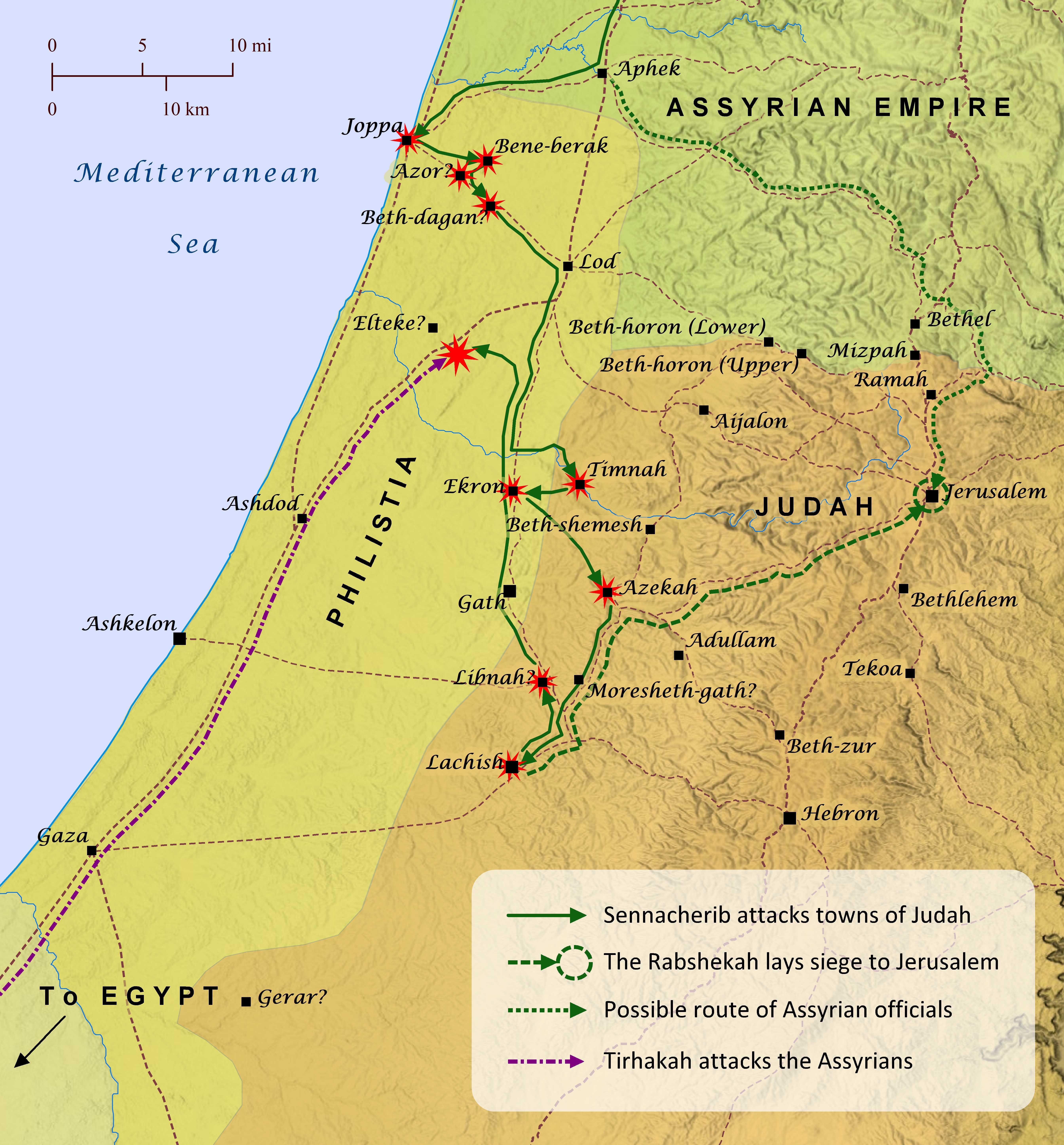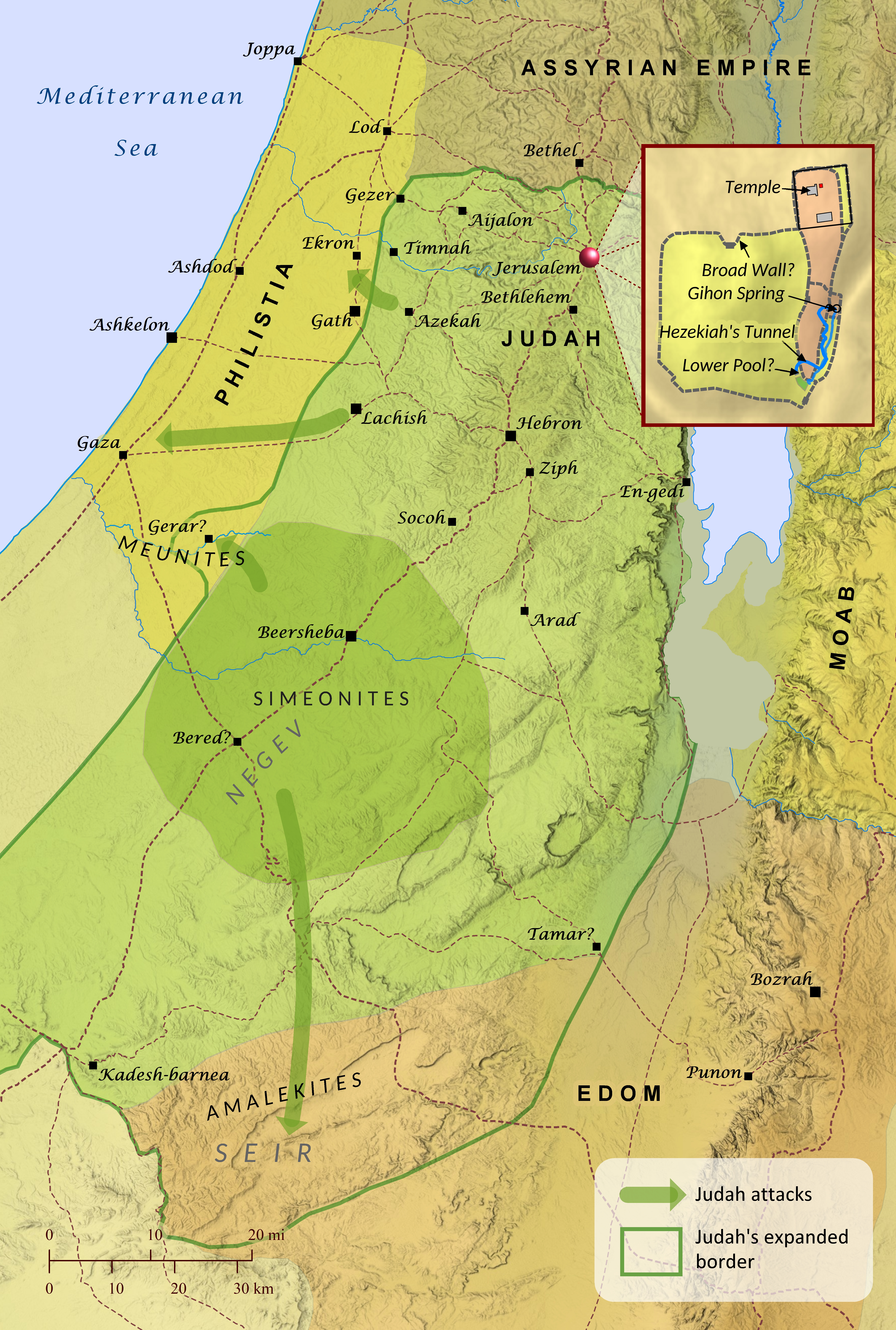
Sennacherib Attacks Judah
Isaiah 36-37; 2 Kings 18-19; 2 Chronicles 32
The harrowing experience of the attack on Judah by King Sennacherib of Assyria during Hezekiah’s reign is recorded by three different writers of Scripture and even by Sennacherib himself. Many scholars also suspect that this event formed the basis for Herodotus’s story regarding an army of mice eating the bow strings of the Assyrian army during their campaign against the Egyptians (Histories, 2.141). The origins of this event stretch back into the reign of Hezekiah’s father Ahaz, who enticed the Assyrians to attack Israel and Aram in exchange for making Judah a vassal of Assyria (2 Kings 16-17; 2 Chronicles 28; Isaiah 7-8; also see “The Final Days of the Northern Kingdom of Israel” map). Judah continued to be a vassal of Assyria through the early part of Hezekiah’s reign, but Hezekiah also quietly made extensive preparations to throw off the yoke of Assyria one day (2 Kings 18:1-12; 1 Chronicles 4:39-43; 2 Chronicles 29-31; also see “Hezekiah Strengthens Judah” map). Hezekiah also appears to have been hoping for support from Babylon and Egypt regarding his efforts to revolt against Assyria’s rule, but the prophet Isaiah warned Judah against placing their hopes in these foreign powers (Isaiah 30:1-5; 31:1-3; 39:1-8; 40:10-15; 2 Kings 20:12-19). After a few years spent quashing rebellion among the Babylonians, the Kassites, and the Medes in the east, Sennacherib turned his sights westward and began a campaign to subdue the various vassal nations that were refusing to submit to Assyria’s rule any longer. He first reconquered the Phoenician cities of Sidon and Tyre and then moved south to Philistia. He subdued Joppa, Beth-dagon, Bene-berak, and Azor and then moved to capture the cities of the Shephelah, which guarded the entrances to the valleys leading into the central hill country of Judah. While Sennacherib was attacking Lachish he sent his officers to demand Hezekiah’s surrender. This may be the Assyrian advance upon Jerusalem from the north described in Isaiah 10:28-32, but this is not certain (see “Assyria Advances on Jerusalem” map). Hezekiah sent officers back to Sennacherib with gold and silver taken from Temple and the royal treasury, but he would not surrender. The officers then traveled to Libnah to meet with Sennacherib, for he gone to fight there by that time. In the meantime King Tirhakah of Cush, who was ruling over Egypt at this time, came to attack Sennacherib, so Sennacherib sent his officials back to Hezekiah with a message that Jerusalem would be taken if he resisted. Hezekiah laid the letter from the officials before the Lord and prayed, and the Lord sent word through the prophet Isaiah that Jerusalem would not be taken. Then that very night the angel of the Lord killed 185,000 Assyrian soldiers (probably those with Sennacherib fighting the Egyptians), and Sennacherib went back to Assyria. There while he was worshiping in the temple of Nisroch, Sennacherib’s sons killed him and fled to Ararat (see “Ararat” map).

Hezekiah Strengthens Judah
2 Kings 18:1-12; 1 Chronicles 4:39-43; 2 Chronicles 29-31
Throughout his reign, Hezekiah strengthened Judah by restoring proper worship of the Lord and preparing the nation for revolt against Assyria. Though the Bible does not clearly say, both of these aspects of Hezekiah’s reign may have been borne out of a desire to undo the detrimental choices of his father, Ahaz, who had promoted idolatry through Judah (2 Chronicles 28:1-4) and made Judah a vassal to the king of Assyria in exchange for help against Israel and Aram (2 Kings 16-17; 2 Chronicles 28; Isaiah 7-8; see also “The Final Days of the Northern Kingdom of Israel” map). Later, when Hezekiah was a teenager, he witnessed Assyria’s grueling three year siege to capture Samaria (2 Kings 17:1-6; 18:9-12), perhaps cementing his resolve to throw off Judah’s yolk of servitude to Assyria (2 Kings 18:7). Whatever the reasons for his actions as king, Hezekiah spent considerable resources promoting the worship of the Lord and preparing for the inevitable Assyrian attack that would follow Judah’s refusal to submit to Assyria any longer. Hezekiah began by directing the priests and Levites to consecrate themselves and restore ritual purity to the Temple and all its furnishings (2 Chronicles 29). He sent word throughout all Israel and Judah to come and celebrate Passover together once again in Jerusalem (2 Chronicles 30). Though only a few from Israel accepted Hezekiah’s invitation, the Passover was a time of great celebration and worship for all who did come from Israel and Judah. After this, the worshipers went throughout Israel and Judah and destroyed the pagan worship centers (2 Kings 18:4; 2 Chronicles 31:1). Hezekiah also conducted a series of actions to strengthen Judah against the coming Assyrian attack. On the west he attacked the Philistines as far as Gaza (2 Kings 18:8). Part of this effort may have included a Simeonite attack on some Meunites in the valley of Gerar (as in the Septuagint; the Hebrew reading Gedor is likely due to a misreading of the letter r as the similarly shaped letter d), which is recounted in 1 Chronicles 4:39-41. Elsewhere in Scripture the Meunites appear to have lived in the region of Seir (2 Chronicles 20), south of Judah, but a remnant of them may have fled toward Gerar during Uzziah’s time when he attacked them and likely took some of them captive to serve at the Temple of the Lord in Jerusalem (Ezra 2:50; Nehemiah 7:52; also see “Resurgence of Israel and Judah” map). Other Simeonites attacked a remnant of Amalekites living in Seir, thus providing increased protection on Judah’s southern border (1 Chronicles 4:39-43). Hezekiah also fortified Jerusalem and redirected various sources of water away from enemies who might lay siege to the city (2 Chronicles 32:1-8). As part of these preparations Hezekiah commissioned the hewing of a tunnel that channeled water from the Gihon spring (probably also called the “waters of Shiloah” in Isaiah 8:6) away from the eastern side of the city and deposited it in the Lower Pool (also called the Pool of Siloam) further inside the city walls. Hezekiah also repaired portions of the wall that were broken down and built a second wall outside it, likely in the Kidron Valley. He also produced many weapons and shields. The writer of Chronicles appears to portray these preparations as being in keeping with Hezekiah’s other acts of faithfulness and righteousness. Some scholars, however, suspect that Isaiah 22:1-14 may reflect another perspective regarding Hezekiah’s preparations, though it is not certain that this passage refers to Hezekiah’s efforts.